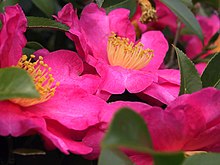Camellias
| Camellia | |
|---|---|
 |
|
| Camellia sasanqua is used as a garden plant, its leaves are used for tea, and its seeds for oil | |
| Scientific classification | |
| Kingdom: | Plantae |
| (unranked): | Angiosperms |
| (unranked): | Eudicots |
| (unranked): | Asterids |
| Order: | Ericales |
| Family: | Theaceae |
| Genus: |
Camellia L. |
| Species | |
|
About 100–250, see text |
|
| Synonyms | |
|
Thea |
|
About 100–250, see text
Thea
Camellia is a genus of flowering plants in the family Theaceae. They are found in eastern and southern Asia, from the Himalayas east to Japan and Indonesia. There are 100–300 described species, with some controversy over the exact number. There are also around 3,000 hybrids. The genus was named by Linnaeus after the Jesuit botanist Georg Joseph Kamel, who worked in the Philippines and described a species of camellia (although Linnaeus did not refer to Kamel's account when discussing the genus). Camellias are famous throughout East Asia; they are known as cháhuā (茶花) in Chinese, "tea flower", an apt designation, as tsubaki (椿) in Japanese, as dongbaek-kkot (동백꽃) in Korean and as hoa trà or hoa chè in Vietnamese.
Of economic importance in the Indian subcontinent and Asia, leaves of C. sinensis are processed to create the popular beverage, tea. The ornamental C. japonica, C. sasanqua and their hybrids are the source of hundreds of garden cultivars. C. oleifera produces tea seed oil, used in cooking.
Camellias are evergreen shrubs or small trees up to 20 m (66 ft) tall. Their leaves are alternately arranged, simple, thick, serrated, and usually glossy. Their flowers are usually large and conspicuous, one to 12 cm in diameter, with five to nine petals in naturally occurring species of camellias. The colors of the flowers vary from white through pink colors to red; truly yellow flowers are found only in South China and Vietnam. Camellia flowers throughout the genus are characterized by a dense bouquet of conspicuous yellow stamens, often contrasting with the petal colors. The so-called "fruit" of camellia plants is a dry capsule, sometimes subdivided in up to five compartments, each compartment containing up to eight seeds.
...
Wikipedia
